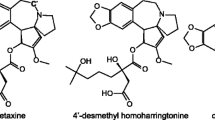Abstract
4-Hydroperoxycyclophosphamide is an oxazaphosphorine which is readily converted without enzymatic involvement to 4-hydroxycyclophosphamide – a key intermediate in the antitumor activity of this class of drugs. The efficacy of 4-hydroperoxycyclophosphamide as a systemically administered antitumor drug was examined in mice bearing EMT-6 mammary carcinoma and in rats bearing 13762 mammary carcinoma in comparison with other oxazaphosphorines. 4-Hydroperoxycyclophosphamide was a more potent tumor cell killing agent than cyclophosphamide or ifosfamide in animals bearing the EMT-6 tumor. There were no significant differences in the toxicity to bone marrow amongst the three oxazaphosphorines. 4-Hydroperoxycyclophosphamide (90 mg/kg) on days 7, 9 and 11 produced 11.5 days of tumor growth delay compared with 10.4 days and 7.1 days for cyclophosphamide (150 mg/kg) and ifosfamide (150 mg/kg) administered on the same schedule, respectively. 4-Hydroperoxycyclophosphamide was tolerated at 90 mg/kg daily for 5 days and at 75 mg/kg twice daily for 4 days producing tumor growth delays of 14.4 days and 16.6 days, respectively. In rats bearing 13762 tumors, 4-hydroperoxycyclophosphamide (90 mg/kg) on days 8, 10 and 12 produced a tumor growth delay of 14.5 days compared with 8.9 days for cyclophosphamide (100 mg/kg) administered on the same schedule. Treatment of 13762 tumor-bearing rats with phenobarbital, pentobarbital or etanidazole increased the tumor growth delay produced by cyclophosphamide while treatment with cimetidine decreased the tumor growth delay produced by cyclophosphamide but not significantly. Administration of 4-hydroperoxycyclophosphamide (90 mg/kg) produced blood concentrations of 4-hydroxycyclophosphamide three-fold higher than those produced by administration of cyclophosphamide (100 mg/kg) at 15 min after drug injection. Treatment with phenobarbital or pentobarbital increased 4-hydroxycyclophosphamide blood concentration while pretreatment with cimetidine decreased 4-hydroxycyclophosphamide blood concentration from cyclophosphamide. 4-Hydroperoxycyclophosphamide is an effective antitumor agent worthy of further investigation.
Similar content being viewed by others
Author information
Authors and Affiliations
Additional information
Received: 25 July 1995/Accepted: 29 January 1996
Rights and permissions
About this article
Cite this article
Teicher, B., Holden, S., Goff, D. et al. Antitumor efficacy and pharmacokinetic analysis of 4-hydroperoxycyclophosphamide in comparison with cyclophosphamide±hepatic enzyme effectors. Cancer Chemother Pharmacol 38, 553–560 (1996). https://doi.org/10.1007/s002800050526
Issue Date:
DOI: https://doi.org/10.1007/s002800050526




